CHAPTER 2
Customizing Windows
Windows comes with a number of features that enable you to personalize your computer. For example, you can change the appearance of Windows to suit your taste, including the Lock screen and the taskbar’s notification area. You can also change the way Windows works to make it easier to use and more efficient. For example, you can make your favorite or most-used apps easier to launch by pinning them to either the Start menu or the taskbar. In this chapter, you also learn how to change the theme, set up multiple monitors, control the volume, set the time zone, and much more.
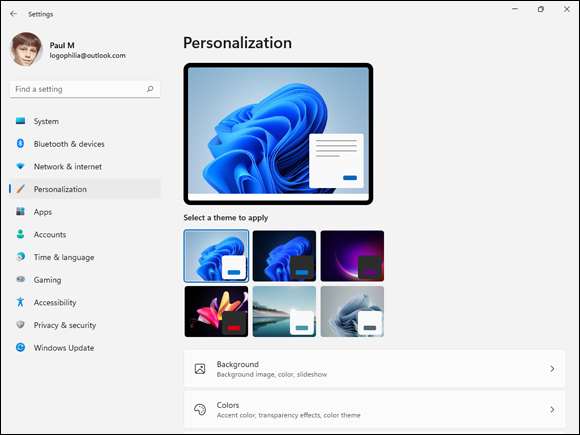
Change the Lock Screen Background
Choose a Lock Screen Status App
Customize Syncing Between Devices
Pin an App to the Start Menu
You can customize the Start menu for quick access to the apps you use most often. If you have an app that does not appear as an icon on the Start menu, you usually open the app by first navigating the Start menu’s apps list to locate the app, possibly negotiating one or more submenus along the way. For apps you use often, you can avoid this extra work by pinning their icons permanently to the main Start menu. After you have pinned an app, you launch it by displaying the Start menu and clicking the app.
Pin an App to the Start Menu
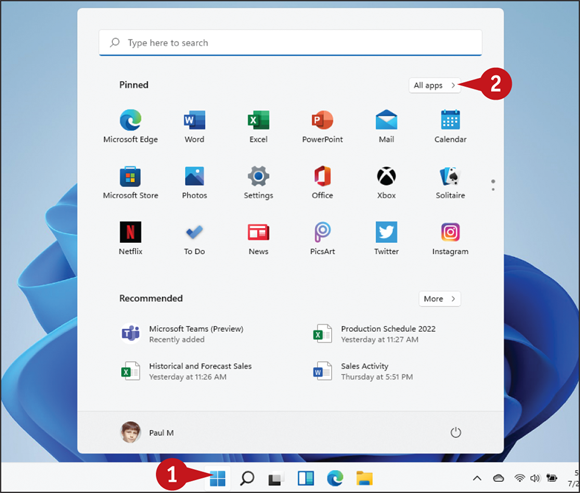
![]() Click Start (
Click Start (![]() ).
).
![]() Click All apps.
Click All apps.

![]() Right-click the app that you want to pin to the Start menu.
Right-click the app that you want to pin to the Start menu.

The app shortcut menu appears.
![]() Click Pin to Start.
Click Pin to Start.
![]() Click Back.
Click Back.

![]() An icon for the pinned app appears on the main Start menu.
An icon for the pinned app appears on the main Start menu.
Note: To remove an app icon from the Start menu, click Start (![]() ), right-click the icon, and then click Unpin from Start.
), right-click the icon, and then click Unpin from Start.
Open the Settings App
You can configure and customize many aspects of your Windows system using the Settings app. Settings is the Windows app that you use for customizing and tweaking your PC. Many of the sections that follow in this chapter, including changing the Lock screen background and adding an app to the Lock screen, are performed using the Settings app. Settings also offers a wealth of other options that you can use to customize your PC.
Open the Settings App

Open the Settings App
![]() Click Start (
Click Start (![]() ).
).
![]() Click Settings.
Click Settings.
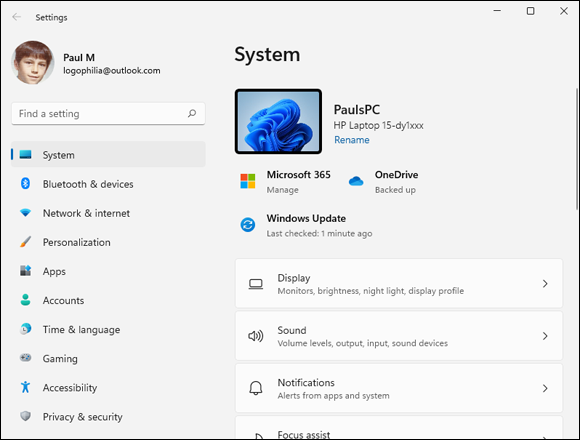
The Settings app appears.
Note: You can also open the Settings app by pressing ![]() +
+ ![]() .
.

Navigate the Settings App
![]() Click a category.
Click a category.
The Settings app displays the category.
![]() Click a subcategory.
Click a subcategory.
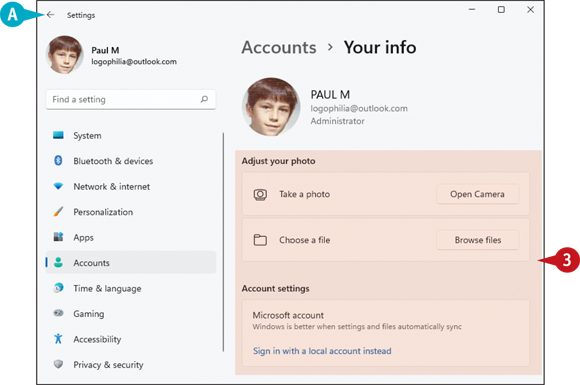
The Settings app displays the settings for the subcategory.
![]() Use the controls on the right side of the app window to modify the tab’s settings.
Use the controls on the right side of the app window to modify the tab’s settings.
Windows puts the new settings into effect.
![]() You can click A Back (
You can click A Back (![]() ) if you need to return to the previous screen.
) if you need to return to the previous screen.
Change the Lock Screen Background
You can make your Lock screen more interesting by changing the image that appears as its background. Locking your computer is a useful safety feature because it prevents unauthorized users from accessing your files and your network. If you find yourself looking at the Lock screen frequently, you might prefer to see something other than the default image. Windows comes with several system pictures that you can use, or you can use one of your own pictures.
Change the Lock Screen Background

![]() Open the Settings app.
Open the Settings app.
Note: See the previous section, “Open the Settings App.”
![]() Click Personalization.
Click Personalization.
The Personalization settings appear.
![]() Click Lock screen.
Click Lock screen.
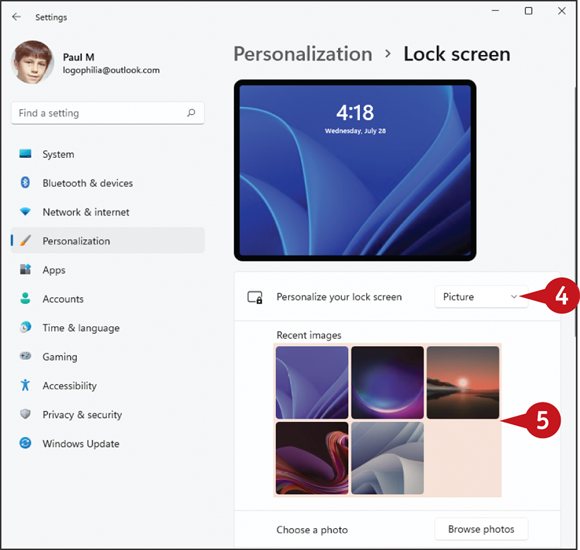
The Lock Screen settings appear.
![]() Click the Personalize your lock screen
Click the Personalize your lock screen ![]() and then click Picture.
and then click Picture.
Note: If you want to use a series of Microsoft Bing photos as the Lock screen background, click Windows Spotlight instead.
![]() To use a default image, click the thumbnail of the picture that you want to use.
To use a default image, click the thumbnail of the picture that you want to use.

![]() To use one of your own pictures, click Browse photos.
To use one of your own pictures, click Browse photos.

![]() Click the picture that you want to use.
Click the picture that you want to use.
![]() Click Choose picture.
Click Choose picture.
The image appears the next time that you lock your computer.
Choose a Lock Screen Status App
You can configure your Lock screen to display the status of an app on your PC. By default, when you lock your PC, Windows displays the status of the Calendar app, so you see new Calendar notifications, such as an upcoming appointment. Windows displays the app’s detailed status, which means that the Lock screen shows more information from the app. For the Calendar app, the Lock screen shows the details of that event, including the event title, location, and time. You can customize your Lock screen to display the detailed status of a different app, such as Weather or Mail.
Choose a Lock Screen Status App

![]() Open the Settings app.
Open the Settings app.
Note: See the section “Open the Settings App” earlier in this chapter.
![]() Click Personalization.
Click Personalization.

The Personalization settings appear.
![]() Click Lock screen.
Click Lock screen.

The Lock screen settings appear.
![]() Click the Lock screen status
Click the Lock screen status ![]() .
.

![]() Click the app for which you want to display its detailed status.
Click the app for which you want to display its detailed status.
Note: If you do not want a detailed status, click None.
Windows puts the new setting into effect, and the app’s status appears on the Lock screen the next time that you use it.
Customize Syncing Between Devices
If, besides your Windows desktop computer, you also have a Windows notebook and a Windows tablet, using the same Microsoft account on each platform means that Windows synchronizes data among them. Windows syncs customizations, such as backgrounds and themes; system settings, such as languages and regional settings; Microsoft Edge data, such as favorites and history; and app settings and more. This gives you a consistent interface across your devices and consistent data so that you can be more productive. However, if there are items you do not want to sync, you can customize the syncing process.
Customize Syncing Between Devices
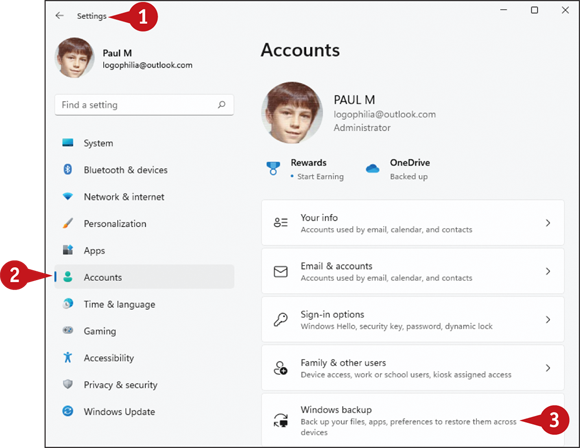
![]() Open the Settings app.
Open the Settings app.
Note: See the section “Open the Settings App” earlier in this chapter.
![]() Click Accounts.
Click Accounts.
The Accounts settings appear.
![]() Click Windows backup.
Click Windows backup.

The Windows backup settings appear.
![]() Click Manage sync settings.
Click Manage sync settings.

The Manage Folder Backup dialog box appears.
![]() To stop a folder from syncing across your devices, click the folder’s Stop backup link and then click Stop backup (not shown) when Windows asks you to confirm.
To stop a folder from syncing across your devices, click the folder’s Stop backup link and then click Stop backup (not shown) when Windows asks you to confirm.
![]() Click Got it.
Click Got it.

![]() If you do not want Windows to sync your apps between devices, click the Remember my apps switch to Off (
If you do not want Windows to sync your apps between devices, click the Remember my apps switch to Off (![]() changes to
changes to ![]() ).
).
![]() Click the Remember my preferences
Click the Remember my preferences ![]() (
(![]() changes to
changes to ![]() ).
).
![]() For each type of preference you do not want Windows to sync between devices, click the preference check box (
For each type of preference you do not want Windows to sync between devices, click the preference check box (![]() changes to
changes to ![]() ).
).
The next time Windows syncs, it does not include the settings that you turned off.
Access an App’s Features
Depending on the app, you might see a few tabs across the top of the window, as well as a Search box in the upper-right corner of the window. However, almost all the apps that come with Windows include a strip running down the left side of the window. This is the app menu, and it gives you access to a number of features, including commands, settings, and views. This menu shows only icons at first, but you can open the menu to display the names of each feature. You can then click the feature that you want to use.
Access an App’s Features
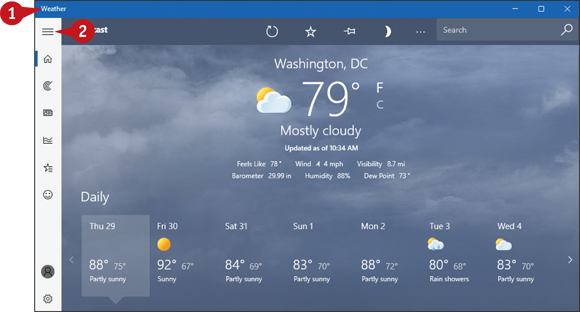
Display the Menu
![]() Open the app that you want to work with.
Open the app that you want to work with.
![]() Click Menu (
Click Menu (![]() ).
).
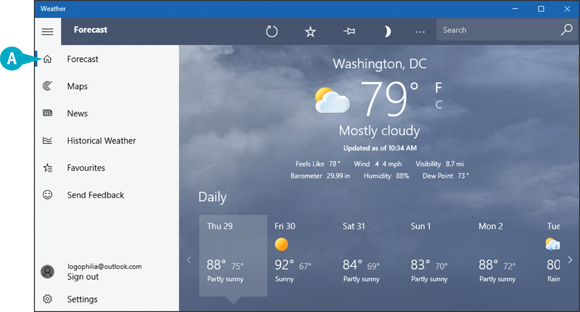

![]() The app menu expands to show the feature names.
The app menu expands to show the feature names.
Hide the Menu
Note: If you click a menu feature, the app automatically hides the menu. You need to manually hide the menu if you decide not to select a feature.
![]() Click Menu (
Click Menu (![]() ).
).

![]() The app hides the menu.
The app hides the menu.
Pin an App to the Taskbar
Pinning an app to the Start menu, as described earlier in this chapter, is helpful because it puts the app just two clicks away. If you have an app that you use frequently, you might prefer to have that app just a single click away. You can achieve this by pinning the app to the taskbar. You can pin an app to the taskbar either from the Start menu or from the taskbar itself.
Pin an App to the Taskbar

Using the Start Menu
![]() Click Start (
Click Start (![]() ).
).
Note: If the app you want to pin appears on the main Start menu, skip to step 3.
![]() Click All apps.
Click All apps.

![]() Right-click the app you want to pin to the taskbar, the Maps app in this example.
Right-click the app you want to pin to the taskbar, the Maps app in this example.
![]() Click More.
Click More.
![]() Click Pin to taskbar.
Click Pin to taskbar.

![]() An icon for the app now appears in the taskbar.
An icon for the app now appears in the taskbar.
Using the Taskbar
![]() Launch the app that you want to pin to the taskbar.
Launch the app that you want to pin to the taskbar.
![]() Right-click the running app’s taskbar icon.
Right-click the running app’s taskbar icon.
![]() Click Pin to taskbar.
Click Pin to taskbar.
![]() Click Close (
Click Close (![]() ).
).

![]() An icon for the app remains on the taskbar.
An icon for the app remains on the taskbar.
Change the Theme
You can add visual interest to Windows by changing the theme. The Windows theme is a set of preferences that includes the desktop background image, the Windows accent color, and whether the interface and apps use light mode (bright colors that work best in daylight or a well-lit room) or dark mode (dark colors that work best at night or in a poorly lit room).
Rather than changing the entire theme, you might prefer to customize only the desktop background. In the Settings app, you can change the background to an image, a solid color, or a slideshow of your photos.
Change the Theme
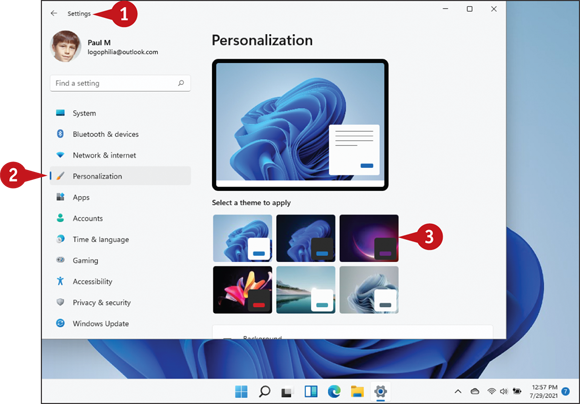
Change the Theme
![]() Open the Settings app.
Open the Settings app.
Note: See the section “Open the Settings App” earlier in this chapter.
![]() Click Personalization.
Click Personalization.
Settings displays the Personalization screen.
![]() Click the theme you want to apply.
Click the theme you want to apply.
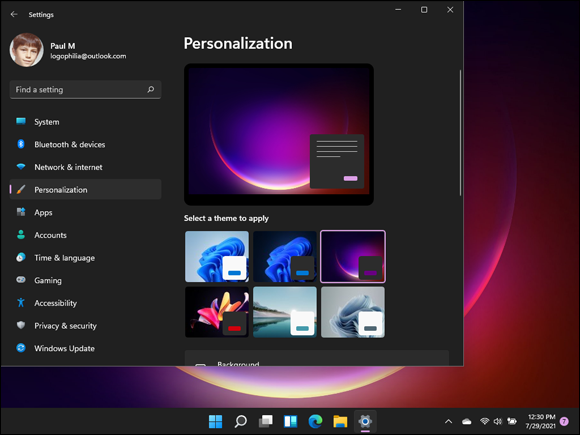
Windows applies the new theme.
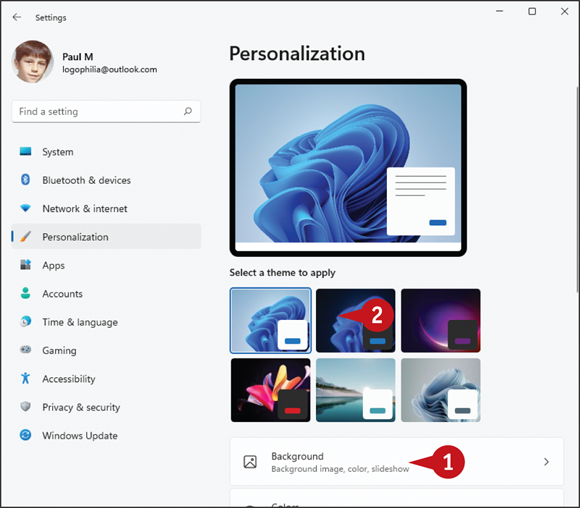
Change the Desktop Background
![]() In the Personalization screen, click Background.
In the Personalization screen, click Background.

Settings displays the Background screen.
![]() Click the Personalize your background
Click the Personalize your background ![]() (
(![]() changes to
changes to ![]() ) and then click the type of background you want:
) and then click the type of background you want:
Picture: Displays an image as the background. Click a picture in the Recent Images section or click Browse a photo to select one of your photos.
Solid color: Displays a color as the background. Click a predefined color swatch or click View colors to create a custom color.
Slideshow: Displays a series of pictures as the background. Click Browse to select the folder that contains the images you want to use.
Adjust the Volume
While an audio or video file is playing, you can adjust the volume up or down to get its audio just right. If you are listening to media by yourself, you can adjust the volume to suit the music and your mood. However, if there are other people nearby, you will probably want to use the volume control to keep the playback volume low to avoid disturbing them. If you need to silence the media temporarily, you can mute the playback.
Adjust the Volume

![]() In the taskbar, click Volume (
In the taskbar, click Volume (![]() ).
).

The Volume window appears.
![]() Click and drag the volume slider (
Click and drag the volume slider (![]() ) to set the volume level that you want.
) to set the volume level that you want.
![]() You can also click Mute (
You can also click Mute (![]() ) to mute the volume (
) to mute the volume (![]() changes to
changes to ![]() ).
).
Windows sets the system volume to the new level.
Set the Time Zone
To ensure that your system clock is accurate, you should set the time zone to correspond to your location. When Windows configures your computer, it performs a number of chores, including setting the current system time and time zone. However, for the time zone, Windows defaults to Pacific Time in North America. If this is not the time zone used where you live, you must select the correct one to ensure that you have the accurate system time.
Set the Time Zone

![]() Open the Settings app.
Open the Settings app.
Note: See the section “Open the Settings App” earlier in this chapter.
![]() Click Time & Language.
Click Time & Language.
![]() Click Date & time.
Click Date & time.

The Date & Time screen appears.
![]() Click the Time zone
Click the Time zone ![]() and then click your time zone.
and then click your time zone.
Windows adjusts the time to the new time zone.
Configure Windows to Work with Multiple Monitors
You can improve your productivity and efficiency by using a second monitor. To work with an extra monitor, your PC must have a second video output port that is compatible with the video input port on the monitor, as well as a cable to connect the ports. Many modern PCs and monitors use HDMI ports connected with an HDMI cable.
After you have connected your PC and the external monitor, you then need to configure Windows to extend the Start screen to both the main screen and the second monitor.
Configure Windows to Work with Multiple Monitors
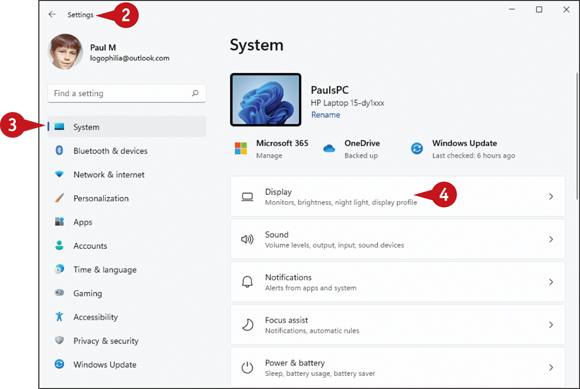
![]() Connect the second monitor to your PC.
Connect the second monitor to your PC.
![]() Open the Settings app.
Open the Settings app.
Note: See the section “Open the Settings App” earlier in this chapter.
![]() Click System.
Click System.
The System settings appear.
![]() Click Display.
Click Display.

The Display settings appear.
![]() Click this
Click this ![]() .
.
![]() Click Extend these displays.
Click Extend these displays.
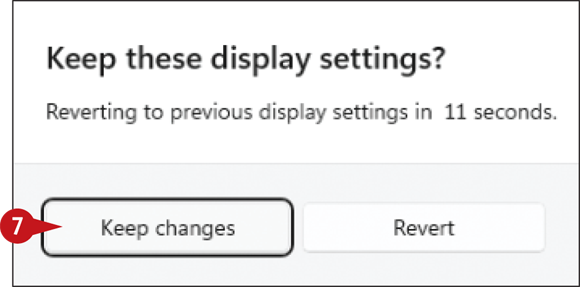
Windows asks you to confirm the display changes.
![]() Click Keep changes.
Click Keep changes.
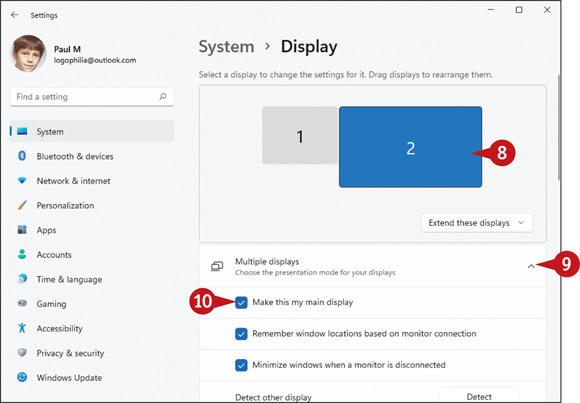
![]() Click the monitor that you want to set as the main display.
Click the monitor that you want to set as the main display.
![]() Click the Multiple displays
Click the Multiple displays ![]() (
(![]() changes to
changes to ![]() ).
).
![]() Click Make this my main display (
Click Make this my main display (![]() changes to
changes to ![]() ).
).
Windows connects to the second monitor and uses the selected monitor as your main display.
Customize the Taskbar
You can customize the items that Windows displays on the taskbar to ensure a particular item is always visible. Windows divides the taskbar into several sections, but the following two are customizable: the main taskbar, which is where you see default items such as Search and Task View; and the taskbar corner, which appears to the right of the main taskbar. For the latter, you have a choice of displaying an icon full-time in the taskbar corner or moving the icon into a hidden area called the taskbar corner overflow menu.
Customize the Taskbar

![]() This area is the main taskbar.
This area is the main taskbar.
![]() This area is the taskbar corner.
This area is the taskbar corner.
![]() Right-click an empty section of the taskbar.
Right-click an empty section of the taskbar.
![]() Click Taskbar Settings.
Click Taskbar Settings.
The Settings app displays the Taskbar settings.
![]() Click the Taskbar items
Click the Taskbar items ![]() .
.

![]() Click the switch to On (
Click the switch to On (![]() changes to
changes to ![]() ) for each icon you want to display in the taskbar.
) for each icon you want to display in the taskbar.
![]() Click the Taskbar corner icons
Click the Taskbar corner icons ![]() .
.
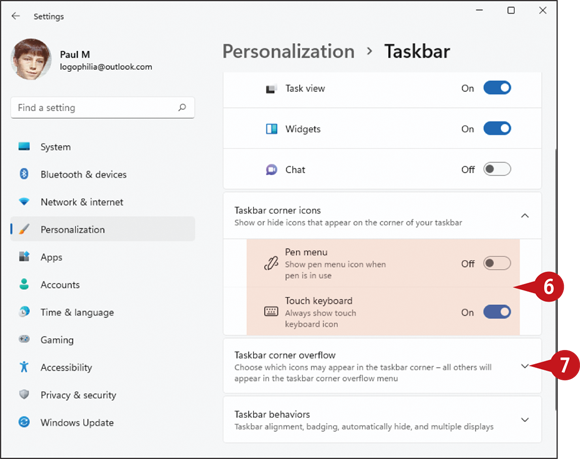
![]() Click the switch to On (
Click the switch to On (![]() changes to
changes to ![]() ) for each icon you want to display in the taskbar corner.
) for each icon you want to display in the taskbar corner.
![]() Click the Taskbar corner overflow
Click the Taskbar corner overflow ![]() .
.

![]() Click the switch to On (
Click the switch to On (![]() changes to
changes to ![]() ) for each icon you want to display in the taskbar corner overflow menu.
) for each icon you want to display in the taskbar corner overflow menu.
Windows puts the new settings into effect.
![]() You can click Show hidden icons (
You can click Show hidden icons (![]() ) to see the icons in the taskbar corner overflow menu.
) to see the icons in the taskbar corner overflow menu.
